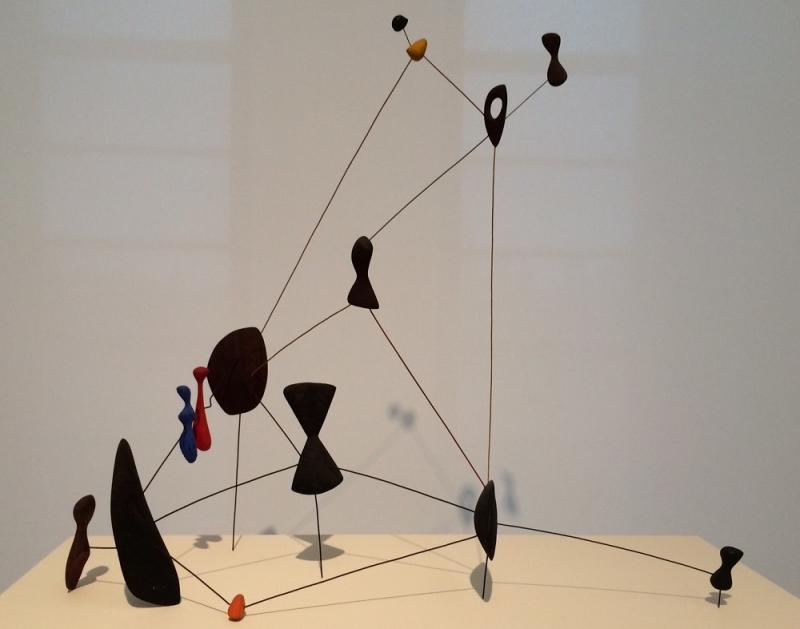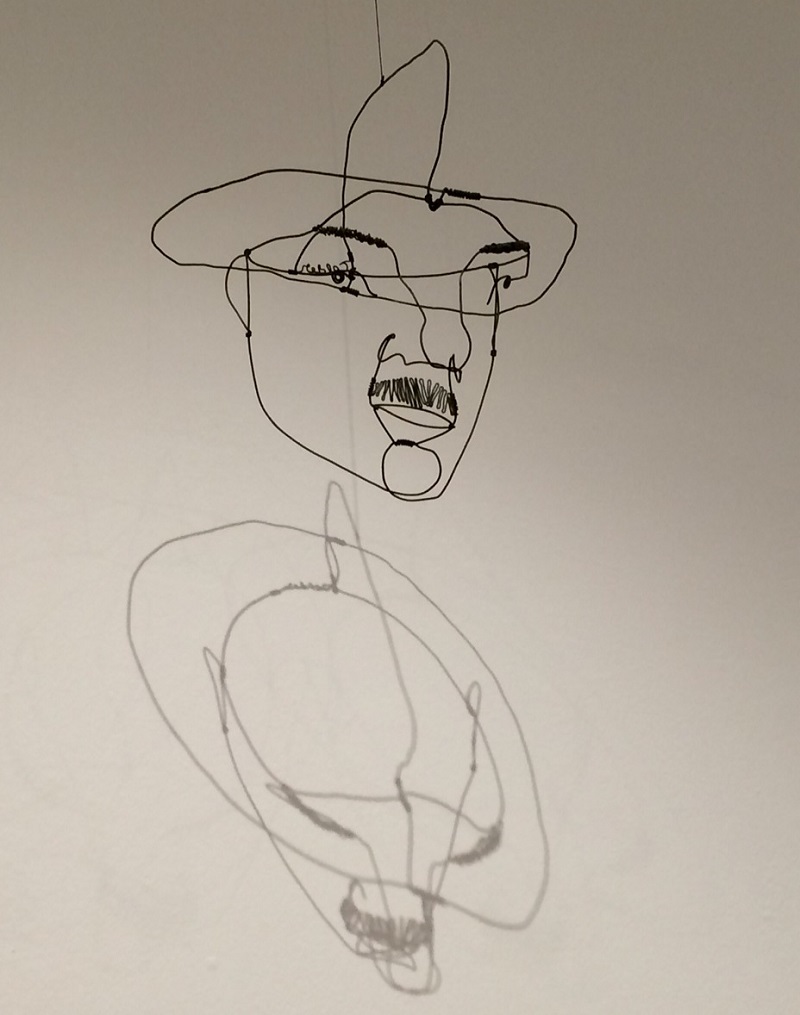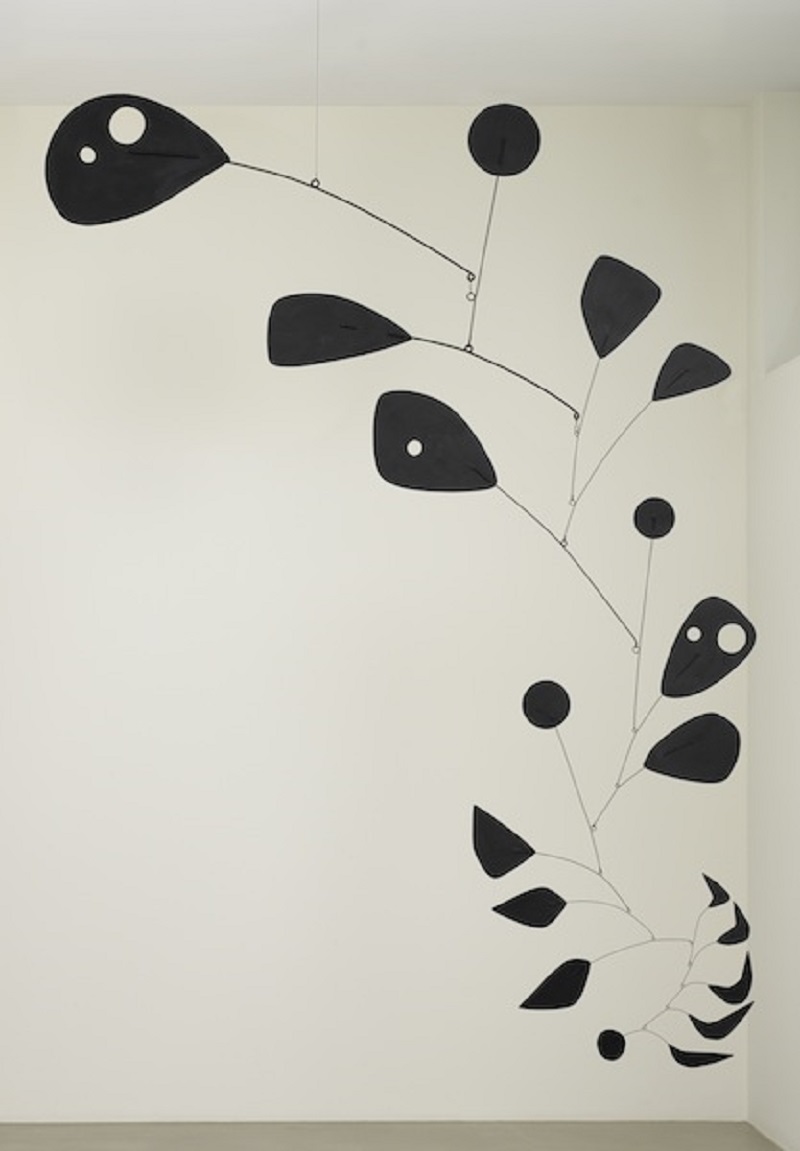Alexander Calder, Tate Modern | reviews, news & interviews
Alexander Calder, Tate Modern
Alexander Calder, Tate Modern
Masterful and pioneering: the American artist’s kinetic sculptures

Sculpture that moves with the gentlest current of air! Sculpture that makes you want to do a little tap dance of joy! Or maybe the Charleston – swing a leg to those sizzling Jazz Age colours and shapes and rhythms. Look, that’s the queen of the Charleston right there – the “Black Pearl” of the Revue Nègre, Josephine Baker. She’s a freestyle 3D doodle in space, fashioned out of wire: spiral cones for pert breasts, that sinuous waist described by a single serpentine line.
Alexander Calder was an American in Paris, depicting the characters he met in the city’s adventurous avant-garde circles. These “open” linear sculptures, hanging off walls and suspended from ceilings like coat hangers, came to be known as his “drawings in space”. With lengths of wire he had the fine facility of Matisse for agile, voluptuous, volumetric form.
 Arriving in Paris in 1926, a relative late-starter at 28, he soon, however, became the Barnum and Bailey of the artistic elite. Carrying his valises filled with tricks and sophisticated toys – circus figures fashioned from wire, wood, cork stoppers, clothes pegs and rubber and fabric – his travelling Cirque Calder was taken from one fashionable salon to another, and performed for friends, including Duchamp, Miró and Mondrian.
Arriving in Paris in 1926, a relative late-starter at 28, he soon, however, became the Barnum and Bailey of the artistic elite. Carrying his valises filled with tricks and sophisticated toys – circus figures fashioned from wire, wood, cork stoppers, clothes pegs and rubber and fabric – his travelling Cirque Calder was taken from one fashionable salon to another, and performed for friends, including Duchamp, Miró and Mondrian.
Mondrian’s by-now bitter rival Van Doesburg was especially enchanted, and though it was Mondrian who would ultimately shape the younger artist’s future, Duchamp’s rotating spirals and Miró’s colourful biomorphic forms certainly both had their impact. One even thinks too of Klee’s exquisite and touchingly comedic Tightrope Walker when it comes to Calder’s finely balanced pieces (Calder called one 1936 work – its delicate wire loops and spirals balanced precariously on a wire strung between two tripod-legged forms – Tightrope).
From his earliest beginnings in Philadelphia, Calder’s future seemed set. His mother was a painter, his father and grandfather (both called Alexander) were successful, even eminent sculptors (one of his father’s most prominent commissions was a stone carving of George Washington, graced by the figures of Wisdom and Justice, on Washington Square Arch). But when he came of age Calder, counter-intuitively, left behind his childhood fascination with art-making to train as a mechanical engineer. After graduation he moved between various jobs, settling for a while as an illustrator. By the time he left for Paris, equipped with his engineering know-how, he was ready to create the complex mechanical circus that would intrigue his artistic friends.
Out of the joyously ramshackle circus came the intricate wire sculptures, first of acrobats and strongmen, then, as we find in Tate’s beautifully designed, spacious survey, his quirky portraits. We see how he moved from a folksy junkyard aesthetic to his more refined and airy sculpture-drawings. But it was only when he visited Mondrian’s Paris studio for the first time that Calder’s breakthrough occurred, and it steered him away from the figurative to his elegantly restrained, hanging abstract forms. Calder was struck by the coloured cardboard rectangles that Mondrian attached to his walls as compositional aids. In fact, he even suggested it might be interesting to make them move. Au contraire. Mondrian replied that his paintings were already “very fast”.
What finally came about wasn’t “very fast” at all, but brightly coloured motorised globes within circular frames that moved slowly, suggesting planetary motion, or more spikily geometric pieces suggesting cosmic constellations (main picture: Constellation, 1943). When A Universe, 1934, was first exhibited at the Museum of Modern Art, New York, Calder was told that Albert Einstein stood watching it for 40 minutes as it went through its 90 cycles of movement before it began to repeat itself. A Universe is one of the very few works stuck behind glass in this exhibition, and it’s now far too fragile to set its motor. Instead we have films of some of the mechanised pieces in elegant flow.
 But even with Calder’s later mobiles (it was Duchamp who invented the term for them; “stabiles” describe those fixed to the floor) the natural world is never far away. The matt-black Vertical Foliage, 1941, hints at a dancing, twirling silhouette of a branch with sprigs in full leaf. And there’s the even more surprisingly sombre Black Widow, 1948 (pictured left), its paddle-shaped black fronds punctured like Swiss cheese. This last, a rare loan, is a 3.5-metre sculpture which normally hangs in the central space of the Institute of Architects of Brazil in São Paulo. Here it hangs alone in the final room of this rich and revelatory survey.
But even with Calder’s later mobiles (it was Duchamp who invented the term for them; “stabiles” describe those fixed to the floor) the natural world is never far away. The matt-black Vertical Foliage, 1941, hints at a dancing, twirling silhouette of a branch with sprigs in full leaf. And there’s the even more surprisingly sombre Black Widow, 1948 (pictured left), its paddle-shaped black fronds punctured like Swiss cheese. This last, a rare loan, is a 3.5-metre sculpture which normally hangs in the central space of the Institute of Architects of Brazil in São Paulo. Here it hangs alone in the final room of this rich and revelatory survey.
There are none of Calder’s rather muddy early single-media paintings in this exhibition – he was certainly never going to be an innovative artist on canvas. But his sculptural evolution, as we see, was both masterful and pioneering.
Explore topics
Share this article
Add comment
The future of Arts Journalism
You can stop theartsdesk.com closing!
We urgently need financing to survive. Our fundraising drive has thus far raised £49,000 but we need to reach £100,000 or we will be forced to close. Please contribute here: https://gofund.me/c3f6033d
And if you can forward this information to anyone who might assist, we’d be grateful.

Subscribe to theartsdesk.com
Thank you for continuing to read our work on theartsdesk.com. For unlimited access to every article in its entirety, including our archive of more than 15,000 pieces, we're asking for £5 per month or £40 per year. We feel it's a very good deal, and hope you do too.
To take a subscription now simply click here.
And if you're looking for that extra gift for a friend or family member, why not treat them to a theartsdesk.com gift subscription?
more Visual arts
 'We are bowled over!' Thank you for your messages of love and support
Much-appreciated words of commendation from readers and the cultural community
'We are bowled over!' Thank you for your messages of love and support
Much-appreciated words of commendation from readers and the cultural community
 Photo Oxford 2025 review - photography all over the town
At last, a UK festival that takes photography seriously
Photo Oxford 2025 review - photography all over the town
At last, a UK festival that takes photography seriously
![SEX MONEY RACE RELIGION [2016] by Gilbert and George. Installation shot of Gilbert & George 21ST CENTURY PICTURES Hayward Gallery](https://theartsdesk.com/sites/default/files/styles/thumbnail/public/mastimages/Gilbert%20%26%20George_%2021ST%20CENTURY%20PICTURES.%20SEX%20MONEY%20RACE%20RELIGION%20%5B2016%5D.%20Photo_%20Mark%20Blower.%20Courtesy%20of%20the%20Gilbert%20%26%20George%20and%20the%20Hayward%20Gallery._0.jpg?itok=7tVsLyR-) Gilbert & George, 21st Century Pictures, Hayward Gallery review - brash, bright and not so beautiful
The couple's coloured photomontages shout louder than ever, causing sensory overload
Gilbert & George, 21st Century Pictures, Hayward Gallery review - brash, bright and not so beautiful
The couple's coloured photomontages shout louder than ever, causing sensory overload
 Lee Miller, Tate Britain review - an extraordinary career that remains an enigma
Fashion photographer, artist or war reporter; will the real Lee Miller please step forward?
Lee Miller, Tate Britain review - an extraordinary career that remains an enigma
Fashion photographer, artist or war reporter; will the real Lee Miller please step forward?
 Kerry James Marshall: The Histories, Royal Academy review - a triumphant celebration of blackness
Room after room of glorious paintings
Kerry James Marshall: The Histories, Royal Academy review - a triumphant celebration of blackness
Room after room of glorious paintings
 Folkestone Triennial 2025 - landscape, seascape, art lovers' escape
Locally rooted festival brings home many but not all global concerns
Folkestone Triennial 2025 - landscape, seascape, art lovers' escape
Locally rooted festival brings home many but not all global concerns
 Sir Brian Clarke (1953-2025) - a personal tribute
Remembering an artist with a gift for the transcendent
Sir Brian Clarke (1953-2025) - a personal tribute
Remembering an artist with a gift for the transcendent
 Emily Kam Kngwarray, Tate Modern review - glimpses of another world
Pictures that are an affirmation of belonging
Emily Kam Kngwarray, Tate Modern review - glimpses of another world
Pictures that are an affirmation of belonging
 Kiefer / Van Gogh, Royal Academy review - a pairing of opposites
Small scale intensity meets large scale melodrama
Kiefer / Van Gogh, Royal Academy review - a pairing of opposites
Small scale intensity meets large scale melodrama
 Jenny Saville: The Anatomy of Painting, National Portrait Gallery review - a protégé losing her way
A brilliant painter in search of a worthwhile subject
Jenny Saville: The Anatomy of Painting, National Portrait Gallery review - a protégé losing her way
A brilliant painter in search of a worthwhile subject
 Abstract Erotic, Courtauld Gallery review - sculpture that is sensuous, funny and subversive
Testing the boundaries of good taste, and winning
Abstract Erotic, Courtauld Gallery review - sculpture that is sensuous, funny and subversive
Testing the boundaries of good taste, and winning
 Edward Burra, Tate Britain review - watercolour made mainstream
Social satire with a nasty bite
Edward Burra, Tate Britain review - watercolour made mainstream
Social satire with a nasty bite

Comments
Nice airy, dancing review,